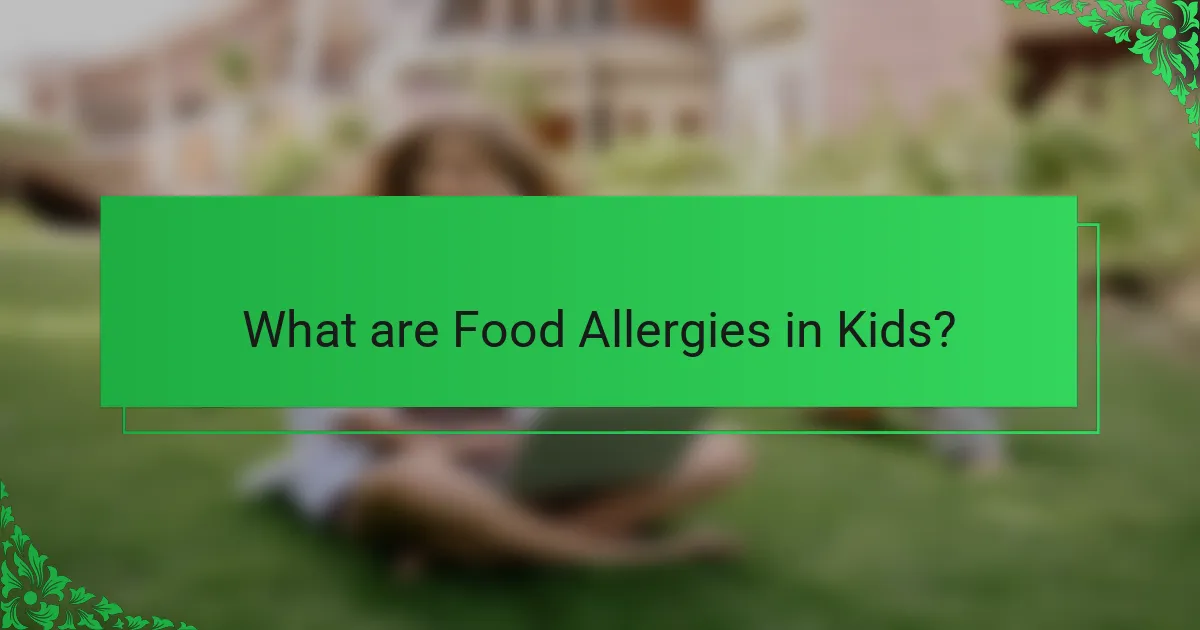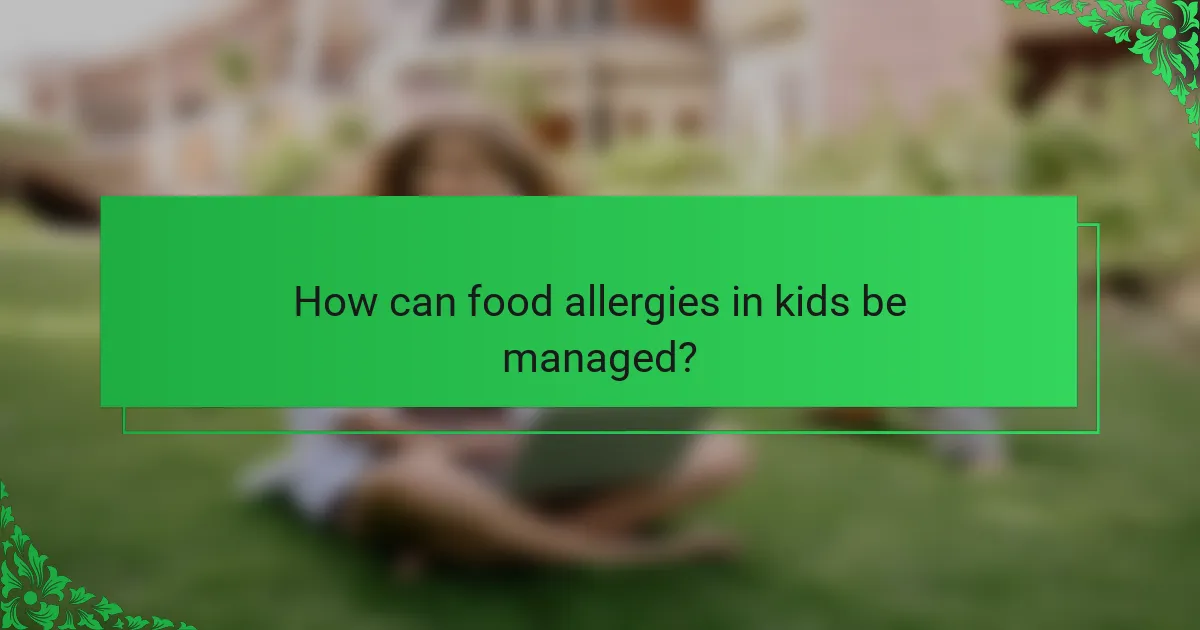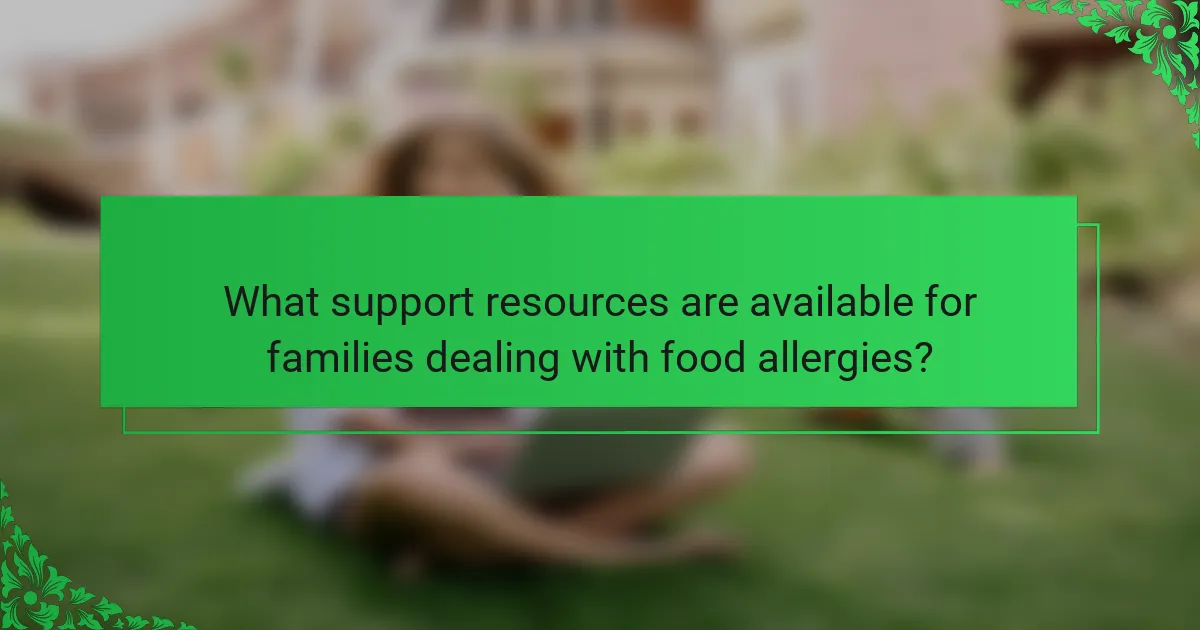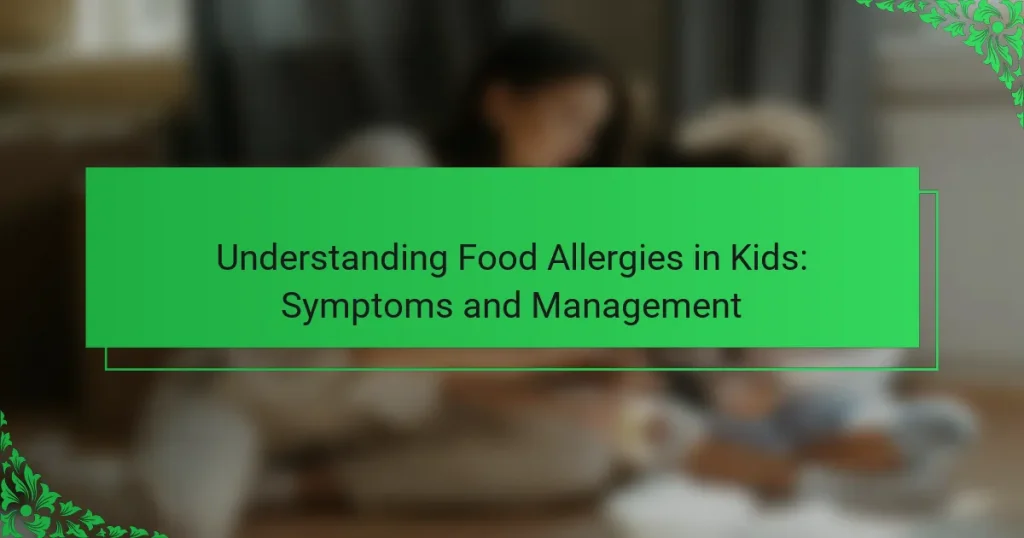
What are Food Allergies in Kids?
Food allergies in kids are immune system reactions to certain foods. These reactions occur when the body mistakenly identifies a harmless food as a threat. Common allergens include milk, eggs, peanuts, tree nuts, soy, wheat, fish, and shellfish. Symptoms can range from mild to severe and may include hives, stomach pain, or difficulty breathing. According to the CDC, food allergies affect approximately 8% of children in the United States. In some cases, reactions can lead to anaphylaxis, a life-threatening condition. Early diagnosis and management are crucial for affected children. Parents should consult with healthcare providers for testing and action plans.
How do food allergies develop in children?
Food allergies in children develop when the immune system mistakenly identifies certain proteins in food as harmful. This immune response leads to the production of antibodies called IgE. Upon subsequent exposure to the same food, these antibodies trigger allergic reactions. Common allergens include milk, eggs, peanuts, and tree nuts. Genetic factors play a role in the likelihood of developing food allergies. Children with a family history of allergies are at higher risk. Environmental factors, such as early exposure to allergens, may influence the development of food allergies. Research indicates that introducing allergenic foods early in life can potentially reduce allergy risk. The prevalence of food allergies in children has increased in recent decades, affecting approximately 8% of children in the U.S.
What genetic and environmental factors contribute to food allergies?
Genetic factors significantly contribute to food allergies. Individuals with a family history of allergies are at a higher risk. Specific genes, such as those involved in immune response, may predispose individuals to food allergies. Environmental factors also play a crucial role. Early exposure to allergens can influence the development of tolerance or sensitization. Additionally, factors like diet, pollution, and microbial exposure affect immune system development. Research indicates that the “hygiene hypothesis” suggests reduced exposure to pathogens may increase allergy risk. Studies show that children who grow up in less sanitized environments have lower allergy rates.
How does the immune system react to food allergens?
The immune system reacts to food allergens by identifying them as harmful substances. This reaction triggers an immune response, which can include the release of histamines and other chemicals. These substances cause symptoms like itching, swelling, and gastrointestinal distress. In severe cases, it can lead to anaphylaxis, a life-threatening reaction. The immune system’s response is mediated by Immunoglobulin E (IgE) antibodies, which specifically target the allergen. Upon first exposure, the body sensitizes itself to the allergen and produces IgE. Subsequent exposures can result in a rapid and intense immune reaction. This process is well-documented in allergy research, highlighting the mechanisms of food allergy responses in children.
What are the common types of food allergies in children?
The common types of food allergies in children include milk, eggs, peanuts, tree nuts, soy, wheat, fish, and shellfish. Milk allergy is one of the most prevalent, affecting about 2-3% of infants. Egg allergy is also common, especially in young children. Peanut allergy has increased significantly in recent years, impacting around 1-2% of children. Tree nut allergies often coincide with peanut allergies. Soy and wheat allergies are prevalent as well, though many children outgrow them. Fish and shellfish allergies tend to persist into adulthood. These allergies can lead to severe reactions, making awareness and management crucial.
Which foods are most frequently associated with allergies in kids?
The foods most frequently associated with allergies in kids include milk, eggs, peanuts, tree nuts, soy, wheat, fish, and shellfish. Milk allergy affects approximately 2-3% of infants and young children. Egg allergies are common, occurring in about 1-2% of children. Peanut allergies are on the rise, affecting around 1-2% of children in the United States. Tree nut allergies also impact many kids, with prevalence rates similar to peanut allergies. Soy and wheat allergies are less common but still significant, affecting about 0.4% and 0.5% of children, respectively. Fish and shellfish allergies are prevalent among older children and adults, with around 0.2% of children affected. These foods account for the majority of allergic reactions in children.
How can parents identify specific food allergies in their children?
Parents can identify specific food allergies in their children by observing symptoms after food intake. Common symptoms include hives, swelling, gastrointestinal issues, or respiratory problems. Keeping a detailed food diary helps track what the child eats and any reactions. Consulting an allergist for skin or blood tests provides further confirmation. The American Academy of Pediatrics states that early identification can prevent severe reactions. Parents should seek immediate medical attention for severe symptoms like anaphylaxis.
What symptoms are associated with food allergies in kids?
Food allergies in kids can cause a variety of symptoms. Common symptoms include hives, itching, and skin rashes. Gastrointestinal symptoms may include vomiting, diarrhea, and stomach cramps. Respiratory issues can manifest as coughing, wheezing, or difficulty breathing. Anaphylaxis is a severe reaction that can occur, leading to swelling of the throat and a drop in blood pressure. According to the American Academy of Pediatrics, these symptoms can appear within minutes to hours after exposure to the allergen. Recognizing these symptoms is crucial for timely intervention and management.
What are the immediate symptoms of food allergies?
Immediate symptoms of food allergies include hives, swelling, and difficulty breathing. These reactions can occur within minutes after exposure to an allergen. Other symptoms may include abdominal pain, vomiting, and diarrhea. Anaphylaxis, a severe allergic reaction, can also happen and requires immediate medical attention. According to the American Academy of Allergy, Asthma, and Immunology, these symptoms can vary in severity and may escalate quickly. Recognizing these symptoms promptly is crucial for effective management and treatment.
What are the delayed symptoms that may occur after exposure?
Delayed symptoms that may occur after exposure to food allergens include hives, eczema flare-ups, gastrointestinal issues, and respiratory problems. These symptoms can manifest hours or even days after exposure. Hives may appear as itchy welts on the skin. Eczema can worsen, leading to increased redness and irritation. Gastrointestinal issues may involve nausea, vomiting, or diarrhea. Respiratory problems can include coughing, wheezing, or difficulty breathing. Research indicates that these delayed reactions can complicate diagnosis and management of food allergies in children.

How can food allergies in kids be managed?
Food allergies in kids can be managed through avoidance, education, and emergency preparedness. Parents should identify and eliminate allergenic foods from their child’s diet. This requires reading food labels carefully to avoid hidden allergens. Education is crucial; children should learn about their allergies and how to communicate them. Schools and caregivers need to be informed about the child’s allergies and emergency procedures. Carrying an epinephrine auto-injector can provide immediate treatment in case of accidental exposure. Regular consultations with an allergist can help in managing the allergies effectively. According to the American Academy of Pediatrics, proper management significantly reduces the risk of severe allergic reactions.
What strategies can parents use to manage food allergies?
Parents can manage food allergies by implementing several effective strategies. First, they should identify and avoid allergens. This involves reading food labels carefully and communicating with caregivers and schools about the child’s allergies. Second, parents must create an emergency action plan. This plan should include steps to take during an allergic reaction, such as administering an epinephrine auto-injector. Third, educating the child about their allergies is crucial. Children should understand what foods to avoid and how to recognize symptoms of an allergic reaction. Additionally, parents can introduce allergen-free alternatives to ensure a balanced diet. Regular consultations with an allergist can provide updated information on managing allergies. Studies show that consistent management reduces the risk of severe reactions and improves quality of life for children with food allergies.
How can parents create a safe eating environment for their children?
Parents can create a safe eating environment for their children by eliminating allergens from the home. This includes reading food labels carefully to avoid hidden allergens. Parents should also educate their children about their specific food allergies. Teaching children to communicate their allergies to others is essential. Designating a specific eating area can help minimize cross-contamination. Regularly cleaning surfaces and utensils is crucial to prevent accidental exposure. Additionally, parents should collaborate with schools and caregivers to ensure safety. Research indicates that a proactive approach reduces the risk of allergic reactions in children.
What role does education play in managing food allergies?
Education plays a crucial role in managing food allergies. It empowers individuals and families to recognize symptoms and avoid allergens. Knowledge about food allergies helps in understanding how to read labels effectively. Education also provides guidance on emergency procedures, such as using an epinephrine auto-injector. Studies show that informed families are better at preventing allergic reactions. Additionally, schools benefit from training staff on allergy management. This reduces the risk of exposure for children with food allergies. Overall, education enhances safety and quality of life for those affected.
What are the emergency protocols for allergic reactions?
In the event of an allergic reaction, the first step is to call emergency services immediately. If the person has a known allergy, administer an epinephrine auto-injector without delay. This medication can reverse severe symptoms like difficulty breathing and swelling. Next, ensure the person is lying down and elevate their legs if they feel faint. Monitor their condition closely until help arrives. If symptoms worsen, a second dose of epinephrine may be necessary after 5 to 15 minutes. Always inform medical personnel about the allergic reaction and any medications given. These protocols are critical in managing life-threatening allergies effectively.
How should parents respond to mild allergic reactions?
Parents should respond to mild allergic reactions by monitoring symptoms closely. They should identify the allergen and avoid further exposure. Administering an antihistamine can help alleviate symptoms such as itching or hives. Parents should ensure the child remains calm and comfortable during this time. It is important to keep the child hydrated. If symptoms worsen or do not improve, seek medical advice promptly. According to the American Academy of Pediatrics, timely intervention can prevent escalation. Always consult a healthcare professional for personalized guidance.
What steps should be taken in case of a severe allergic reaction?
Administer epinephrine immediately if a severe allergic reaction occurs. This is crucial to counteract anaphylaxis. Call emergency services right after administering the epinephrine. Position the person lying down and elevate their legs if possible. Monitor their breathing and heart rate closely. If symptoms do not improve within 5 to 15 minutes, a second dose of epinephrine may be needed. Avoid giving any food or drink until medical help arrives. Always carry an epinephrine auto-injector if a severe allergy is known.

What support resources are available for families dealing with food allergies?
Families dealing with food allergies can access various support resources. Organizations like the Food Allergy Research & Education (FARE) provide educational materials and advocacy. Local support groups offer community connections and shared experiences. Healthcare providers can guide families on management strategies and emergency plans. Online forums and social media groups allow for peer support and information sharing. Schools often have resources for allergy management and safety protocols. Government health websites also provide guidelines and resources for food allergy awareness.
What organizations provide information and assistance for food allergies?
Organizations that provide information and assistance for food allergies include the Food Allergy Research & Education (FARE), the American Academy of Allergy, Asthma & Immunology (AAAAI), and the Asthma and Allergy Foundation of America (AAFA). FARE offers resources on managing food allergies and advocacy for those affected. The AAAAI provides educational materials and guidelines for healthcare professionals. The AAFA focuses on awareness, education, and support for individuals with allergies. These organizations are recognized for their contributions to food allergy research and support.
How can support groups help families navigate food allergies?
Support groups can help families navigate food allergies by providing emotional support and sharing practical advice. These groups create a safe space for families to express their concerns. Members can share their experiences and coping strategies. Many support groups offer resources about allergy management and safety measures. They may also provide information on local allergists and nutritionists. Research shows that families engaged in support networks report feeling less isolated. This connection can lead to increased confidence in managing food allergies. Overall, support groups empower families with knowledge and community support.
What are practical tips for managing food allergies in daily life?
Practical tips for managing food allergies in daily life include reading food labels carefully. This helps identify allergens in packaged foods. Always inform restaurants about specific food allergies before ordering. Carry emergency medication, such as an epinephrine auto-injector, at all times. Create a food allergy action plan with a healthcare provider. Educate family and friends about the allergies to ensure support. Avoid cross-contamination by using separate utensils and cooking surfaces. Regularly review and update allergy management strategies as needed. These steps help ensure safety and minimize the risk of allergic reactions.
How can families prepare for dining out with food allergies?
Families can prepare for dining out with food allergies by researching restaurants in advance. They should review menus online to identify potential allergens. Contacting the restaurant beforehand can clarify their ability to accommodate food allergies. Families should communicate specific allergies clearly to the staff upon arrival. Carrying a list of allergies can help ensure nothing is overlooked. It’s beneficial to have an emergency plan in place, including carrying necessary medications like antihistamines or epinephrine auto-injectors. Educating children about their allergies can empower them to speak up. Lastly, choosing restaurants known for allergy-friendly practices can enhance safety.
What are some effective strategies for reading food labels?
Effective strategies for reading food labels include checking the ingredient list, identifying allergens, and understanding nutritional information. The ingredient list is typically arranged by quantity, with the most abundant ingredients listed first. This helps consumers identify potential allergens. Common allergens include peanuts, tree nuts, dairy, eggs, soy, wheat, fish, and shellfish. Understanding serving sizes is crucial for interpreting nutritional information accurately. This allows for better management of dietary needs, especially for children with food allergies. Additionally, consumers should look for certifications, such as “gluten-free” or “nut-free,” which can provide extra assurance. Reading labels carefully can significantly reduce the risk of allergic reactions.
Understanding food allergies in kids is essential for effective management and prevention of severe reactions. This article outlines the immune system’s response to allergens, common types of food allergies, and their symptoms, which can range from mild to life-threatening. It also highlights the genetic and environmental factors contributing to food allergies, strategies for identifying and managing these conditions, and available support resources for families. Parents will find practical tips for ensuring a safe eating environment and guidance on emergency protocols for allergic reactions.




